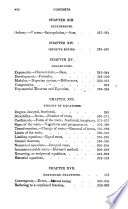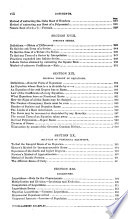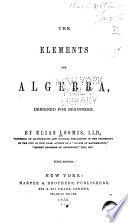 | Stephen Chase - Algebra - 1849 - 348 pages
...ac+bc+ay+by. See §67. Hence, we have, for the multiplication of polynomials, the following RULE. § 71. Multiply each term of the multiplicand by each term of the multiplier, and add the products. See Geom. §178. Cor. III. a.) This is precisely the method employed in Arithmetic. Thus, to multiply... | |
 | Thomas Lund - Algebra - 1851 - 186 pages
...7. . . 16, p. 25.] 23. To multiply one quantity by another, when both consist of two or more terms. RULE. Multiply each term of the multiplicand by each term of the multiplier, according to the rule for single terms, and the SUM of these separate products will be the product... | |
 | William Smyth - Algebra - 1851 - 272 pages
...polynomials: 1°. Arrange th« proposed polynomials according to the powers of the same letter. 2°. Multiply each term of the multiplicand by each term of the multiplier, observing that if the terms are affected each with the same sign, the product should have the sign... | |
 | Joseph Ray - Algebra - 1852 - 408 pages
...terms in each are positive, we have the following RULE FOE MULTIPLYING ONE POLYNOMIAL BY ANOTHER. — Multiply each term of the multiplicand by each term of the multiplier, and add the products together. EXAMPLES. 2. Multiply x-\-y by a-\-c. Ans. ax-\-ay-\-cx-\-cy. 3. Multiply 2a4-3z by 3o;+2z.... | |
 | Benjamin Greenleaf - Algebra - 1853 - 370 pages
...11 by — am. Ans. CASE III. 84. When both the multiplicand and multiplier are compound quantities. RULE. Multiply each term of the multiplicand by each term of the multiplier, remembering that the product of like signs is -\-, and the product of unlike signs is — ; then add... | |
 | Benjamin Greenleaf - Algebra - 1854 - 414 pages
...— am. Ans. CASE HI. 84. When both the multiplicand and multiplier are compound quantities. RTJLE. Multiply each term of the multiplicand by each term of the multiplier, remembering that the product of like signs is -[-, and the product of unlike signs is — ; then add... | |
 | Elias Loomis - Algebra - 1855 - 356 pages
...that is, we are to multiply a+b by c and d successively, and add the partial products. Hence we deduce the following RULE. Multiply each term of the multiplicand by each term of t/ie multiplier separately, and add together the products. Multiply a+b 3x+2y ax+b 3a+ x By a+b 2x+3y... | |
 | William Smyth - Algebra - 1855 - 370 pages
...From what has been done we have the following rule for the multiplication of polynomials, viz. 1°. Multiply each term of the multiplicand by each term of the multiplier, observing with respect to the signs, that if two terms multiplied together have each the same sign,... | |
 | Elias Loomis - Algebra - 1856 - 280 pages
...that is, we are to multiply a+b by c and d successively, and add the partial products. Hence we deduce the following RULE. Multiply each term of the multiplicand by each term of the multiplier separately, and add together the products. Examples. (1.) (2.) (3.) Multiply a+b 3x+2y ax+b by a+b... | |
 | Archibald Montgomerie - Algebra - 1857 - 116 pages
...Multiply each of its terms by the other factor. 20. When both factors are compound. Multiply eacli term of the multiplicand by each term of the multiplier, and add the partial products, as in Arithmetic. Multiply EXERCISES. (1.) a by Ь Ans. a6. (2.) .«e by y. ....... | |
| |